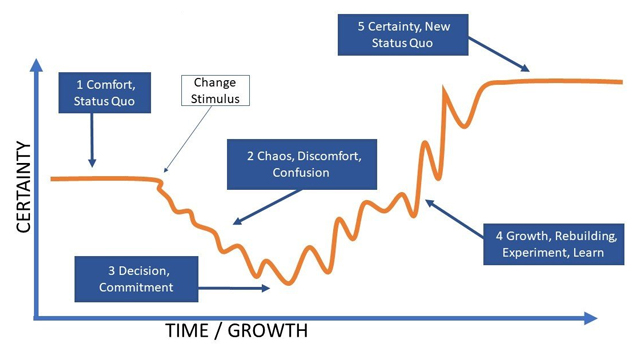This is a guest post by Tim O’Connor, the Founder and Strategic Projects Lead at Results, a firm specializing in the development and execution of strategies and processes that improve organizational alignment and communication. The team at Results has been driving things at Compass Collective, and supporting organizations with change throughout the crisis.
Many say the only constant today is change, and the pace of change we are experiencing now is unprecedented in human history. Technology, communications, globalization, and a connected world of over 7.5 billion people are just some of the reasons driving the pace of change. And to be successful in our communities and businesses, we need to get good at change.
This is nothing new for business leaders. Conrad Hilton founded the Hilton hotel group in the early 1900s, and is credited with saying:
“There are 3 types of companies:
- Those that make things happen,
- Those that watch things happen, and
- Those who wonder what happened.”
The implication here is clear. Organizations that are not only comfortable with change, but those that can be on the leading edge of change have the advantage.
The Change Valley
Despite its importance, change can also be problematic for people. It usually involves uncertainty, stress, and discomfort. This is especially true when the change trigger or stimulus happens to us as opposed to us initiating the change. Examples of this could include suddenly losing a job, having an unexpected competitor enter the market, or discovering a family member has an illness.

We can better manage change in our lives by identifying the feelings we are having using a model called the “Change Valley”. This model helps us to plot where we are in the process of change, and what the next steps may be. Most change follows this pattern, though the time spent in each phase and the depth of the “valley”, can differ greatly.
To better illustrate how this model works, let’s take the example of learning to drive a car. Before the change stimuli, the status quo is using other modes of transportation: friends, family, public or private transportation systems. Then the stimulus arrives either as a proactive decision (I want to learn to drive) or a reaction to something externally (my parents want me to drive). That trigger moves us into the valley as we begin our learning. In the early days it’s very uncertain, even frightening, as we get behind the steering wheel for the first time. We try, we fail, we experiment, we practice, we make mistakes and hopefully we keep trying. Then slowly, sometimes very slowly, we begin to climb back out of the valley as we grow in confidence, skill and certainty. Ultimately, we reach the far side of the valley, a new status quo, with greater certainty and growth than the starting point.
In some cases, people are unsuccessful in crossing the valley. This can happen for many reasons; maybe the journey is too long or hard, or the valley too deep for that individual’s fortitude. Maybe circumstances change such that the goal is no longer attractive or worthwhile. Or possibly the expected resources or support don’t show up. In these situations, a person will often climb back to the starting side of the valley, returning to the original status quo.
Change and Learning
“The end of learning is not knowledge, but action.”
Herbert Spencer
The example provided above is not just a journey of change, but also a journey of learning; the two always go hand in hand. To deal with or capitalize on change, we must learn new skills and behaviours. And by increasing our skills by learning new behaviours, we are more willing and able to initiate and activate change in our businesses and lives. Learning and change are inseparable.
In our work here at Results we are very blessed to interact with the people in our society who are very skilled in the change-learning equation. These are the entrepreneurs in our communities. I like to call them the “Change Sherpas”, those people who are rarely satisfied with the status quo and who seem to be constantly looking for the next change valley to dive into (and yes, they often drive their employees and families crazy).
And don’t underestimate the importance of the Change Sherpas. A glance at our nation’s commercial statistics will show that net employment growth for the past 25 years does not come from big companies or the public sector. It comes from small and medium sized entrepreneurial companies. These firms, and their leaders, drive the economic engine.
Leading Change
Understanding and using the Change Valley Model is a valuable tool for leaders. Change is often initiated and guided by leaders, and they can help their people see where they are in the model, validate feelings, and help them get to the next stage. These leaders are the Sherpas for their teams as they travel through the valley by providing encouragement, support, route advice, and regular reminders of how great the view will be on the other side.